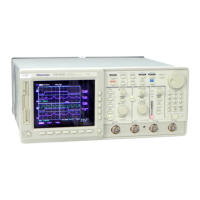Triggering on Waveforms
3–82
TDS 500B, TDS 600B, & TDS 700A User Manual
NOTE. If you select Trigger if Faster Than and the oscilloscope does not trigger,
it may be because the pulse edge is too fast rather than too slow. To check the
edge speed, switch to edge triggering. Then trigger on the pulse edge and
determine the time the edge takes to travel between the levels set in the slew rate
Thresholds menu. The oscilloscope cannot slew rate trigger on pulse edges that
traverse between threshold levels in 600 ps or less.
Also, to reliably slew rate trigger, a pulse must have a width of 7.5 ns or more. A
pulse of less width may trigger on the wrong slope or not trigger at all. Switch to
edge triggering and check the pulse width if you can’t slew rate trigger as
expected.
Trigger Bar at Upper Threshold
Trigger Bar at Lower Threshold
Cursors Measure Slew Rate
Components of Pulse Edge—dv and dt
Trigger Point at Second Crossing
Figure 3–46: Main Trigger Menu — Slew Rate Class
To understand what happens when you slew rate trigger, study Figure 3–46 as
you consider the following points:
The main menu shows the oscilloscope is set to trigger based on the slew
rate of a pulse input to the trigger source, Ch 1. It is set to monitor the
positive-polarity pulse edges of the trigger source and to trigger on any edge
with a slew rate faster than the slew rate setting.
The Trigger When side menu displays the readout Slew Rate that indicates
the slew rate setting. The slew rate setting is not the slew rate of the pulse;
instead, it is the slew rate against which the oscilloscope compares the slew

